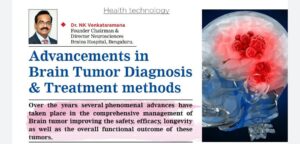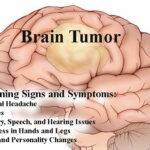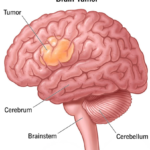Brain tumor can affect any age group starting from paediatric to geriatric age groups. Over the years several phenomenal advances have taken place in the comprehensive management of Brain tumor improving the safety, efficacy, longevity as well as the overall functional outcome of these tumors.


Brain tumor can affect any age group starting from paediatric to geriatric age groups. The tumors vary in their origin, clinical presentation biological behaviour and prognosis in different age groups. By and large brain tumor can arise from all the structures in the cranium that includes skull bones, cartilages, meninges, brain parenchyma blood vessels choroid plexus, pituitary, spineal gland and the cranial nerves. In addition metastatic tumor can come to brain from various systemic malignancies.
Over the years several phenomenal advances have taken place in the comprehensive management of brain tumor improving the safety, efficacy, longevity as well as the overall functional outcome of these tumors. The technology and innovations have improved the visibility, accessibility, receptibility and overall ability to treat. Brain tumor outcomes are no longer dismal. However, there are few malignant brain tumors which need definitive answers. The improvements are in several spheres.
1. Diagnosis – MRI has revolutionized the diagnosis of brain tumors. Even the smallest tumors can be diagnosed with Gadolinium contrast. MR Spectroscopy can reasonably predict the nature of the tumor. Diffusion Tensor Imaging of the brain can give valuable information about the displacement of important structure in the brain by the tumor. Similarly in eloquent areas including the brain stem, PET CT or MRI will be very useful in accurately determining the size of the tumor, particularly in metastatic brain tumor.
2. Surgery – Microsurgery has provided magnification depth illumination and visibility making the tumor accessible to the surgery regardless of the location. Intra-operative ultrasound can accurately locate the deep seated tumors and guide the surgeons to reach all the shortest trajectory. Intra operative MRI can help the surgeons to get real time information about the extent of removal thereby facilitating gross total resection of these tumors.
Radio frequency bipolar and laser systems can make the total removal as well as supramaximal resection in selective intra-parenchymal tumors. Ultra-sonic surgical aspirator will help the surgeons to break the hard tumors into pieces and remove step by step without disturbing the surrounding parenchyma. Neuro-navigation systems provides real time imaging guidance all through the surgery keeping the three dimensional orientation to the surgeon and helps to prevent transgressing into normal brain tissues.
The intra operative fluorescence will highlight the tumor with a different colour under the fluorescent microscope. One should be able to resect the tumor hidden as islands between the normal tissues thus achieving complete removal. Complete removal of brain tumor has been proven to offer better longevity and lesser chances of recurrence beyond doubt. Finally, neuroleptanalgesia will facilitate awake brain surgery in all eloquent areas making sure of brain function throughout the surgery .A variety of haemostats are now available to control the bleeding and to achieve haemostasis quickly. Advances in neuro-anaesthesia have made all these techniques including the intra operative brain function monitoring possible.
3. Molecular Diagnosis – Brain tumor diagnosis has gone much beyond the simple histological cell based diagnosis. In the present day battery of tests provides information on gene modification, mutation, deletion, proliferative index, molecular markers, enzymes, factors that up regulate or down regulate the molecular pathways and immuno histological data that helps in deciding upon the type of treatment as well as prediction of outcomes (prognosis as well as chances of recurrence). This research has identified several abnormal genes that facilitates the formation of tumors as well as influences the recurrence.
This has the future implications and will enable successful gene editing that can alter the profile and course of the tumor. Significant research is on the way to make this as a notable therapy. The molecular mechanisms and its understanding are paving the way for the introduction of targeted therapy for the tumors. Several such molecules and the nucleotides are already in the market and several others are under clinical research and trials.
It is the hope that this will be the future gold standard of therapy for many tumors. Immunological modulation is another method of combating the brain tumor growth. This is also in the experimental phase. Enzyme intervention and blocking the metabolic pathways of the tumors to prevent them from growing is another notable method to fight these tumors.
4. Tumor Stem Cell Concepts – Tumor Stem cell concepts that nurtures and propagates the tumors as well as responsible for recurrence is another target for the future treatment of brain tumor. The tumor cells escape the natural immunological surveillance within the body thereby surviving in the safe hideouts to cause recurrence as well as to metastasize. Targeting these cells will technically provide the eradication and elimination of the tumorogenic process within the system. Brain tumor vaccine is customized and tailor made to each individual, is another method that is being tried in some of the management of brain tumors.
5. Adjuvent Therapy – Many malignant tumors require adjuvant therapy to enhance the progress and reduce the chances and recurrence.
6. Radiotherapy – Several advances have taken place in the delivery of radiation to the brain tumor. The image guidance, stereotactic system has improvised precise delivery of high dose radiation purely to the tumor protecting the surrounding brain tissues from the effects of radiation. Thus stereotactic radio therapy delivers high dose radiation to the tumor as a single fraction or divided as small fraction.
This technique is proved to improve the overall outcomes as well as the progression in many tumors. This technique is particularly useful for the elderly, for those who cannot undergo surgery as well as patient with recurrence. This can be offered as a primary treatment in small benign tumors in small children. Similarly, after the surgery the tumor bed can be radiated to prevent regrowth or recurrence. Proton beam therapy is a new addition that can provide better result with lesser toxicity and are particularly useful to treat children with brain tumors.
Several molecular mechanisms are being unravelled by continuous research and this has contributed to the current understanding of various brain tumors and their histological as well as biological behaviour. It has also paved the way for the current understanding as well as newer classification of the brain tumors. The on-going research is expected to provide much more insight that will guide the clinicians to make more accurate diagnosis as well as add many therapeutic options in the years to come.
Also Read: Brain : The King and a King maker


Dr. NK Venkataramana
Founder Chairman & Director Neurosciences
Brains Super Speciality Hospital, Bengaluru.











